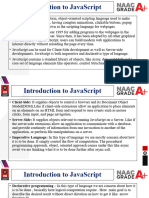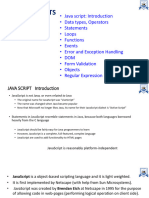0% found this document useful (0 votes)
18 views21 pagesUnit 3
This document provides an overview of scripting and networking concepts, focusing on JavaScript, its features, history, applications, and key components such as variables, data types, operators, control structures, functions, and objects. It also introduces AJAX as a technique for creating dynamic web applications that communicate with servers without refreshing the page. Additionally, the document includes examples and explanations of JavaScript's usage in HTML forms and networking fundamentals.
Uploaded by
nadeemmehraj368Copyright
© © All Rights Reserved
We take content rights seriously. If you suspect this is your content, claim it here.
Available Formats
Download as PDF, TXT or read online on Scribd
0% found this document useful (0 votes)
18 views21 pagesUnit 3
This document provides an overview of scripting and networking concepts, focusing on JavaScript, its features, history, applications, and key components such as variables, data types, operators, control structures, functions, and objects. It also introduces AJAX as a technique for creating dynamic web applications that communicate with servers without refreshing the page. Additionally, the document includes examples and explanations of JavaScript's usage in HTML forms and networking fundamentals.
Uploaded by
nadeemmehraj368Copyright
© © All Rights Reserved
We take content rights seriously. If you suspect this is your content, claim it here.
Available Formats
Download as PDF, TXT or read online on Scribd
/ 21
























































































